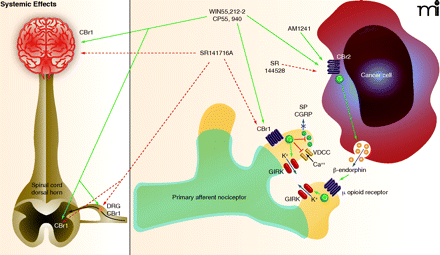
- Institution: Stanford Univ Med Ctr Lane Med Lib/Periodical Dept/Rm L109
- Sign In as Member / Individual
Mechanism of Cancer Pain

Cannabinoid receptor (CBr) agonists and antagonists act peripherally in the cancer microenvironment on CBr1 and CBr2 subtypes and have central effects when administered systemically. CBr agonists reduce cancer-induced nociception. In the carcinoma microenvironment, CBr1 receptors are found on the primary afferent nociceptive free nerve endings, whereas CBr2 might be present on the carcinoma cells given that they are found on keratinocytes. Activation of peripheral CBr1 reduces hyperalgesia by opening G protein–coupled inwardly rectifying potassium (GIRK) channels, by inhibiting voltage-dependent calcium channels (VDCC), and by inhibiting release of substance P (SP) and calcitonin gene–related peptide (CGRP). An additional mechanism for reducing cancer-induced nociception, including mechanical allodynia, comes from activation of CBr2 on the carcinoma cell, which potentially leads to secretion of beta-endorphins, as occurs in keratinocytes. The endorphins activate mu opioid receptors on the peripheral nociceptive afferent, which open GIRK channels. WIN 55,212-2 and CP 55,940 are non-selective CBr agonists. AM1241 is a selective CBr2 agonist. Selective antagonists include SR141716A for CBr1 and SR144528 for CBr2. The left-hand side of the figure illustrates additional sites of actions for systemic administration of agonists or antagonists of CBr1, namely the dorsal root ganglion cell body, the dorsal horn presynaptic terminals of the primary afferent neuron, and the brain. (See text for details and references. Blue arrows indicate secretion. Green arrows indicate agonism or activation. Red arrows indicate antagonism; red blunt arrows represent inhibition).


